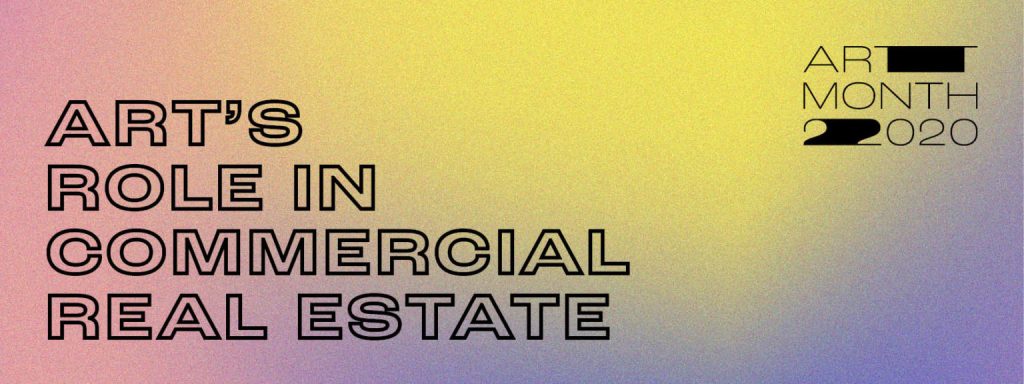Art’s Role in Commercial Real Estate

The virtual adaptation of this year’s Art Month allowed us to shine a spotlight on the talented individuals shaping the District’s art scene and expand the dialogue around the art community beyond our doors. Through a three-part webinar series, we invited key stakeholders in the art world—from curators and artists to developers and more—with diverse backgrounds and perspectives to comment on art’s unification qualities and identify the ways in which it impacts our society on a daily basis.
Our first panel, Art’s Role in Commercial Real Estate, focused on the convergence of private and public art to aid with communicating brand identity, distinguishing neighborhoods, and adding tangible value to properties and the communities that surround them. Host Sarah Barr, Principal and Director of Hickok Cole Creative was joined by Stacy Skalver, President of ArtMatters, Ryan Stewart, Senior Development Manager at Grosvenor Americas, and Robin-Eve Jasper, President of NOMA BID.
If you missed the conversation, don’t worry. You can revisit the recording, or read on for our top three takeaways from Art’s Role in Commercial Real Estate.
Communicate brand identity and make a good first impression
When trying to appeal to a particular target market, art can serve as a striking differentiator. Commissioned work in particular allows you to have more influence over what goes into your space and helps create an authentic environment. Stacy Sklaver, President of ArtMatters shares that her process begins by asking clients about their vision and mission. “Art is the first thing you see when you walk into an office or lobby and it’s the last thing you see when you’re leaving, so it should speak to who you are.”
The right kind of piece can make a long-lasting impression and contribute to a unique experience for clients or visitors. Sarah Barr, Director of Hickok Cole Creative works frequently with artists on her projects. “Art can be used as a means for storytelling, especially when working on a repositioning project and trying to find ways to renew the space or make it feel different,” she says. “It’s important to think about what the experience will be like for people in the building but also how it impacts the streetscape and passersby.”

Invest in the community to ensure long-term success
A decade ago, graffiti was considered unappealing and devaluing, but in today’s urban landscape murals and even graffiti art have become ubiquitous. In fact, choose any city and a guided tour of street art is certain to be available — visibility that would be attractive to any developer. So what’s changed? For one, the convergence of private and public art in the form of lobby art galleries or entrance plaza sculptures has helped turn ordinary buildings into landmarks.
“The value of these kinds of art pieces help to place properties psychographically in the public mind. They experience a place in a way that’s emotional. Pow! Wow! DC has really come to characterize NOMA, making it known as the mural capitol of DC,” says Robin-Eve Jasper, President of NOMA BID. And that’s translated into a positive for the neighborhood and the city as a whole. “It’s impossible to value at the art piece level but generally, NOMA has contributed well over a billion dollars in fiscal revenue to the city over the past 14 years or so and if there was no identity here, I think we would have seen a much smaller effect. What’s great is that we can enable artists to really express their authentic vision while improving the connectivity and make unappealing spaces appealing.”
Start early to tell the right story (and stay within budget)
As liaison to the gallery or artist and the client, consultants assist with many of the logistics — including installation and maintenance — associated with having an art program and are equipped with the knowledge and network to do so efficiently. They are responsible for sourcing artists and curating works that accurately reflect their client’s brand while adhering to their budget. But all of that takes time. Ryan Stewart, a Senior Development Manager at Grosvenor Americas suggests getting a consultant on board as early as possible to ensure the greatest return on your investment. “The longer the lead times, the more flexibility you have to commission pieces and the easier it is to work with the interior designers to ensure the artwork complements their design and vice versa,” says Ryan.
Cost is an unfamiliar factor for many people purchasing artwork and one that usually goes underestimated. Stacy added that “too often what goes on the walls is the final consideration on a project which usually means there’s little budget left for what the client is trying to achieve.” Stacy stated that the earlier consultants get involved the better. “For many of our clients, this is the first time they’re doing something of this nature. Every medium is different and as consultants, we can advise our clients as to what things cost. We’re educators.”




